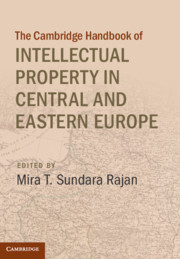Book contents
- The Cambridge Handbook of Intellectual Property in Central and Eastern Europe
- The Cambridge Handbook of Intellectual Property in Central and Eastern Europe
- Copyright page
- Dedication
- Epigraph
- Contents
- Figures
- Tables
- Contributors
- Foreword
- Acknowledgements
- 1 General Introduction – Intellectual Property in Central and Eastern Europe:
- 2 The Patent System in Pre-1989 Czechoslovakia
- 3 The Development of Hungarian Copyright Law until the Creation of the First Copyright Act (1793–1884)
- 4 Moral Rights and the Cultural Aspects of Hungarian Copyright Law:
- 5 The Polish Struggle with the Concept of Copyrightable Work:
- 6 Comparing Concepts of Originality in EU, Lithuanian, and US Law:
- 7 The Comparative Lessons of Itar-Tass Russian News Agency v. Russian Kurier
- 8 Communication to the Public under Union Law from the Perspective of Austrian and German Copyright Law: A Notion in Transition
- 9 Collective Management of Copyright in Hungary1
- 10 Exceptions and Limitations:
- 11 The Digitization of Czech Cultural Heritage and New Forms of Information Exclusivity
- 12 The Treatment of Authors’ Moral Rights in Georgia
- 13 Performers’ Rights: A Central European Export
- 14 The White Elephant in the Room:
- 15 A Central and Eastern European Perspective on EU Copyright Reform:
- 16 The Painter, the One Horn Cow, and Ole Hank Wilson’s Back Lot:
- 17 Does Paying Innovative Employees Pay Off?:
- 18 Intellectual Property Rights in Albania:
- 19 The Protection of Geographical Indications for Agricultural Products in the European Union
- 20 Legal Protection of the Traditional Knowledge and Traditional Cultural Expressions of the Indigenous Peoples of the Former Soviet Union*
- Index
4 - Moral Rights and the Cultural Aspects of Hungarian Copyright Law:
1945–2000
Published online by Cambridge University Press: 11 June 2019
- The Cambridge Handbook of Intellectual Property in Central and Eastern Europe
- The Cambridge Handbook of Intellectual Property in Central and Eastern Europe
- Copyright page
- Dedication
- Epigraph
- Contents
- Figures
- Tables
- Contributors
- Foreword
- Acknowledgements
- 1 General Introduction – Intellectual Property in Central and Eastern Europe:
- 2 The Patent System in Pre-1989 Czechoslovakia
- 3 The Development of Hungarian Copyright Law until the Creation of the First Copyright Act (1793–1884)
- 4 Moral Rights and the Cultural Aspects of Hungarian Copyright Law:
- 5 The Polish Struggle with the Concept of Copyrightable Work:
- 6 Comparing Concepts of Originality in EU, Lithuanian, and US Law:
- 7 The Comparative Lessons of Itar-Tass Russian News Agency v. Russian Kurier
- 8 Communication to the Public under Union Law from the Perspective of Austrian and German Copyright Law: A Notion in Transition
- 9 Collective Management of Copyright in Hungary1
- 10 Exceptions and Limitations:
- 11 The Digitization of Czech Cultural Heritage and New Forms of Information Exclusivity
- 12 The Treatment of Authors’ Moral Rights in Georgia
- 13 Performers’ Rights: A Central European Export
- 14 The White Elephant in the Room:
- 15 A Central and Eastern European Perspective on EU Copyright Reform:
- 16 The Painter, the One Horn Cow, and Ole Hank Wilson’s Back Lot:
- 17 Does Paying Innovative Employees Pay Off?:
- 18 Intellectual Property Rights in Albania:
- 19 The Protection of Geographical Indications for Agricultural Products in the European Union
- 20 Legal Protection of the Traditional Knowledge and Traditional Cultural Expressions of the Indigenous Peoples of the Former Soviet Union*
- Index
Summary
From the legal historian’s point of view, we can say that economy and society “shape” law, or that law “influences” economy and society, or that law and economy and society are all “mutually constitutive.”2 These assertions particularly apply to the examination of moral rights in the legal history of copyright law in Hungary and, more generally, in other Central and Eastern European countries. These countries are unique in that they share a socialist period in their history, which points to an interesting connection between the moral rights of authors and the struggle to overcome political repression. As Sundara Rajan has pointed out, with bitter irony, the ideological aspects of socialism imbued all human expression with powerful political connotations.3
- Type
- Chapter
- Information
- Publisher: Cambridge University PressPrint publication year: 2019

